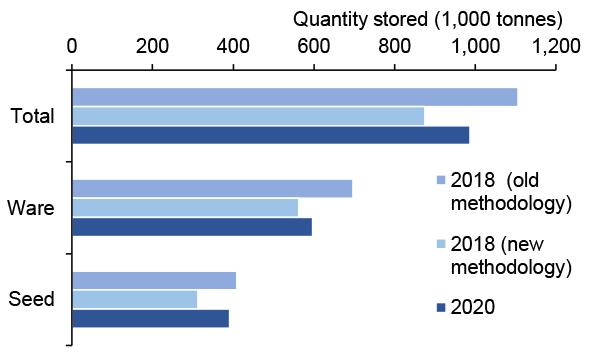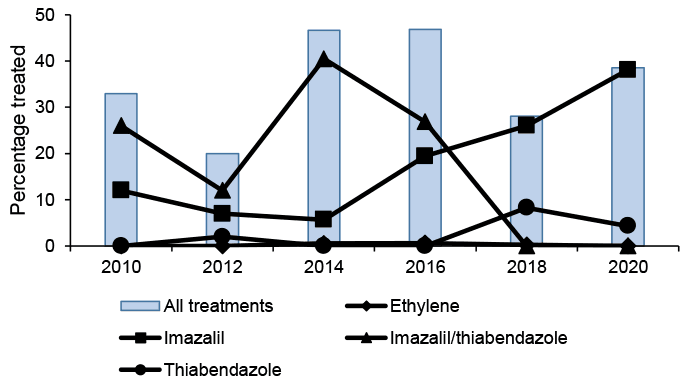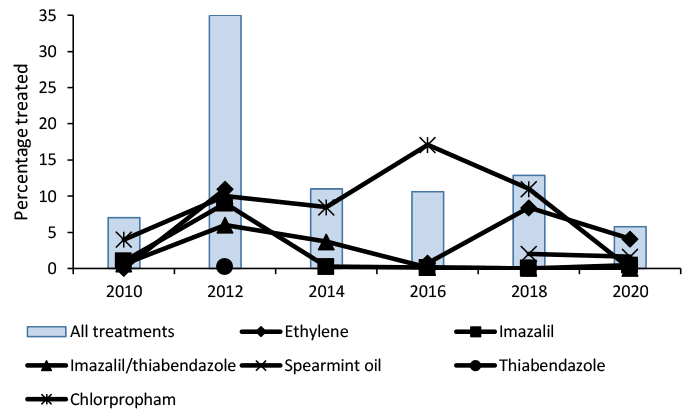Pesticide usage in Scotland: arable crops and potato stores 2020
This publication presents information from a survey of pesticide use on arable crops and potato stores in Scotland during 2020.
General trends
Scottish potato storage
The total estimated quantity of potatoes stored in Scotland in 2020 was 987,615 tonnes. This is 11 per cent less than that reported in 2018(3) (1,105,891 tonnes) and 13 per cent less than in 2016(4) (1,140,286 tonnes). However, there has been a significant change in survey methodology which must be taken into account when comparing data from this survey and previous surveys (see Appendix 4 – changes from previous years for further information). The new method significantly reduces the estimated proportion of potatoes held in store. Had the new method been applied in 2018 the estimated quantity of potatoes stored in Scotland in 2018 would have been 875,687 tonnes. Therefore, the estimated quantity of potatoes stored in Scotland in 2020 was actually 13 per cent higher than in 2018 (Figure 1).
The quantity of seed potatoes stored in 2020 was estimated to be 391,208 tonnes (Table 1). Had the new methodology used in the current survey been applied in the previous survey in 2018, this would represent a 25 per cent increase in seed stored between 2020 and 2018 (Figure 1). AHDB reported that domestic and non-EU seed sales were very slow in 2020 resulting in higher storage figures as of the end of November as growers were unsure of their planting intentions as they held off to see what the impact of covid measures would be (AHDB pers.comm.). However, seed growers in Scotland were encouraged to export seed to the EU and NI early before these markets closed to them on the 1st of January 2021 following EU exit, although this only equates to approximately 15,500 tonnes (SPCS, SASA pers.comm.).
The estimated quantity of ware potatoes stored in 2020 was 596,407 tonnes. Had the new methodology been applied in the previous survey, there would have been an estimated 562,894 tonnes of ware potatoes stored in 2018. Therefore, there was an estimated six per cent increase in stored ware potatoes between 2018 and 2020 (Figure1). This increase in storage is possibly influenced by covid restrictions which depressed consumer demand for ware potatoes during 2020. Data from AHDB suggest overall GB grower held potato stocks, as at the end of November 2020 were up 4.7 per cent on the 5 year average (2015-2019)(5).
As in 2018, all potatoes surveyed in 2020 were stored in boxes. In previous surveys, very few bulk stores were encountered (<0.5 per cent of stored crops in 2016). Seed crops were mainly held in refrigerated stores (60 per cent) with the remainder in ambient ventilated stores (39 per cent) and a very small proportion in unventilated stores (<0.5 per cent). The majority of seed crops were also held in refrigerated stores in 2018 and 2016 (67 and 61 per cent respectively).
Ware potatoes were mostly refrigerated in 2020 (86 per cent) with the remaining 14 per cent in ambient ventilated stores. In previous surveys a very small proportion was encountered in unventilated stores (<0.5% in 2018). The proportion of ware potatoes held in refrigerated stores appears to be increasing with 86 per cent in 2020 compared to 80, 77 and 66 per cent of ware tubers held in refrigerated stores in 2018, 2016 and 2014 respectively.

Please note, there has been a significant change in survey methodology which must be taken into account when comparing data from 2020 and previous surveys, see Appendix 4 for further information. The above figure presents the estimated total potato storage in Scotland for 2018 using both the previous and current methodology for comparison purposes.
Pesticide usage
Seed potatoes
The proportion of seed potatoes treated with a pesticide in 2020 was 39 per cent. This is within the range of estimated use in previous surveys (28 per cent treated in 2018 and 47 per cent treated in 2016 and 2014) (Figure 2). Pesticide use on seed potatoes in 2018 was considered to be low, with the assumption that this was influenced by the good quality of seed potatoes harvested that year.

All of the pesticides used in seed potato stores in 2020 were fungicides (Figure 3, Table 2). In 2020 the most commonly used fungicide was imazalil applied to 38 per cent of the seed crops and thiabendazole applied to four per cent. In 2018, the most commonly used fungicide was also imazalil applied to 26 per cent of the crop and thiabendazole applied to eight per cent of the crop.
Prior to 2018 the most commonly used fungicide was a formulation of imazalil/thiabendazole which was applied to 27 per cent of stored seed in 2016 and 40 per cent in 2014. This imazalil/thiabendazole formulation lost approval in 2015 and had a final use date of June 2017. Since then, imazalil and thiabendazole have been applied as single active substance products in seed stores. Whilst imazalil use has increased over time, thiabendazole has not, this may be influenced by the occurrence of resistance to thiabendazole in some storage diseases(6).
Unlike previous surveys, where a small proportion (<1 per cent) of stored seed potatoes were treated with ethylene, no ethylene was recorded on stored seed potatoes in 2020. In these previous surveys, ethylene use on seed potatoes was only encountered in one commercial store which is no-longer operating. Ethylene, which is generated from ethanol, is not approved as a plant protection product for stored seed potatoes. However, it is approved as a commodity substance for plant growth regulation for post-harvest crops under COPR(7).

Ware potatoes
The proportion of stored ware potatoes treated with a pesticide was six per cent, less than half that of the 13 per cent in 2018 and 11 per cent in 2016 (Figure 2). This may have been influenced by the reduced number of approved products available following the loss of the growth regulator active substance chlorpropham.
Less than 0.5 per cent of the stored crop was treated with a fungicide in 2020. Overall, the quality of crops lifted in Scotland was good in 2020 and the disease risk was generally low(8). Historically, with the exception of 2012, which was an outlier, less than five per cent of stored ware potatoes have been treated with a fungicide over the last decade.
Almost all the pesticide used in ware stores were growth regulators (>99 per cent, Figure 4). This is the first survey since the withdrawal of Chlorpropham which had a final use of date of 8th October 2020. Chlorpropham had been the principal active substance in 2018 and 2016 (applied to 11 and 17 per cent respectively). Ethylene was applied to an estimated four per cent of the stored ware potato crop in 2020, compared with eight per cent in 2018 and one per cent in 2016. Spearmint oil, which is a sprout suppressant applied as a fog in store was applied to an estimated two per cent of the stored ware potato crop in both 2020 and 2018. Therefore, the loss of chlorpropham does not appear to have increased the use of other growth regulators in store during 2020. However, an increase in the use of maleic hydrazide, applied as a field treatment to prevent sprouting during storage was recorded in the 2020 Pesticide Usage in Arable Crop report. Maleic hydrazide was applied to eight per cent of the ware crop in 2020, compared to two per cent in 2018. Although it should be noted that the use of growth regulators has shown variation over time, as have the compounds encountered (Figure 4) and it is difficult to interpret trends within this data series.

Contact
Email: psu@sasa.gov.scot
There is a problem
Thanks for your feedback